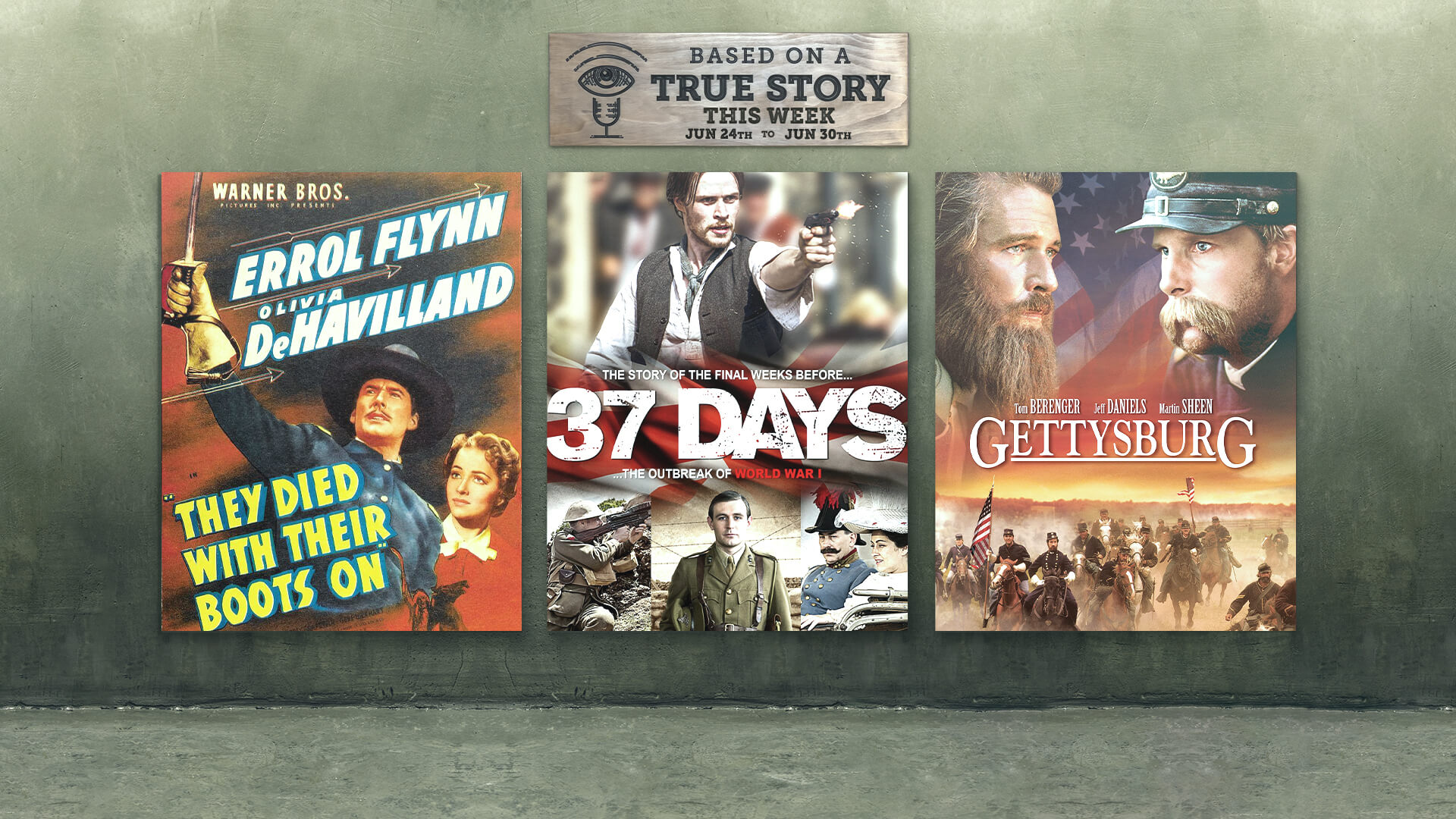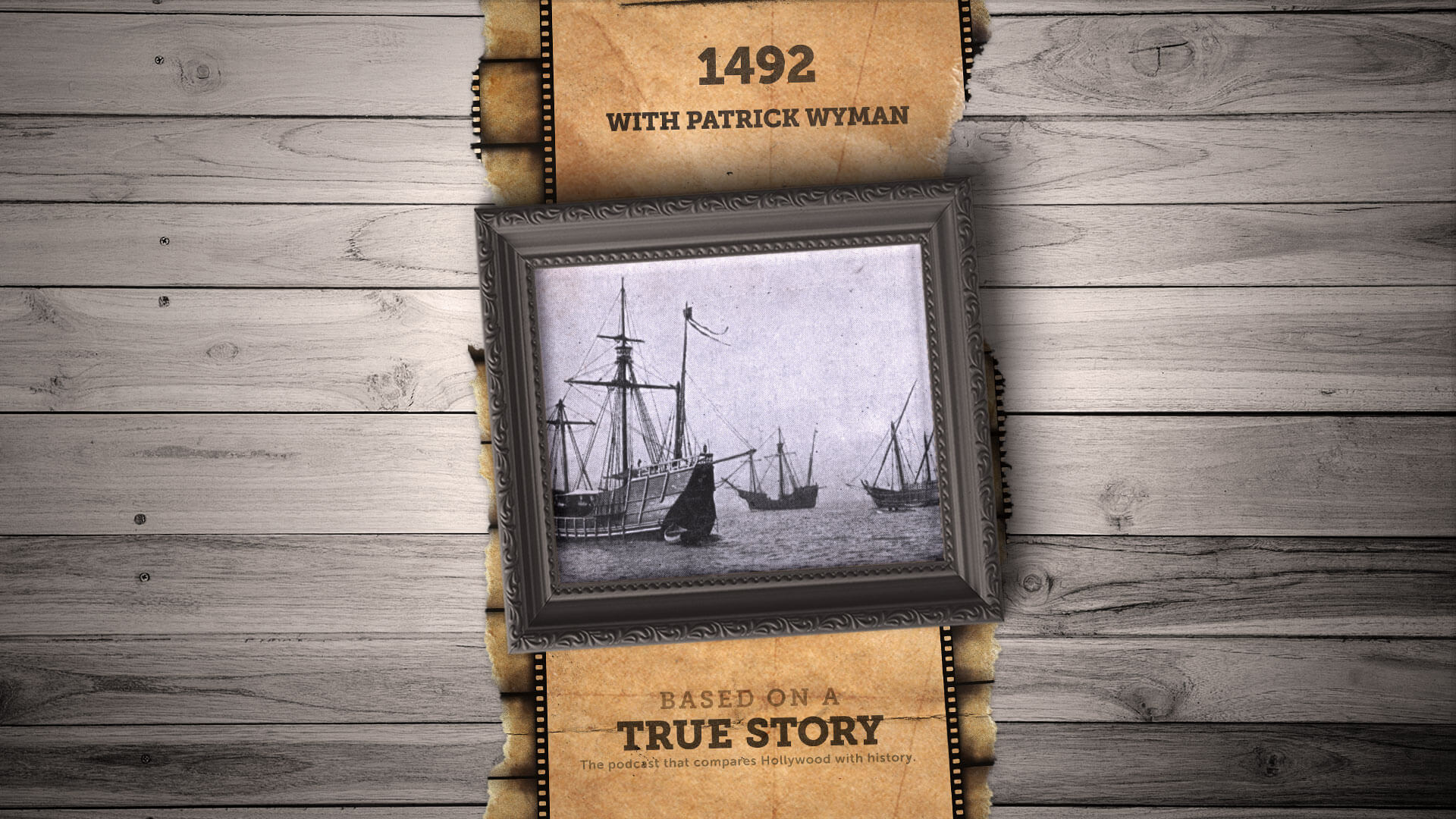In this episode, we’ll learn about historical events that happened this week in history as they were depicted in Sweet Dreams, Pompeii, and Saving Mr. Banks.
Did you enjoy this episode? Help support the next one!
Disclaimer: Dan LeFebvre and/or Based on a True Story may earn commissions from qualifying purchases through our links on this page.
Transcript
Note: This transcript is automatically generated. There will be mistakes, so please don’t use them for quotes. It is provided for reference use to find things better in the audio.
August 21, 1961. Nashville, Tennessee.
There’s a band playing music. We’re in a recording studio with four men and one woman. Almost immediately, there’s an oddity as the woman is holding herself up with a crutch.
No one is playing their instruments, but we can hear music playing…it must be something playing over the speakers in the studio. She hobbles over to the pianist, who is busy jotting down some notes.
She rests her crutch on the piano as the man keeps singing the song in the background, “I’m crazy for feeling so blue…”
She waves to the guys in the sound booth to cut the song.
She shakes her head.
“I don’t care how many times you play that, I can’t sing this man’s song.”
One of the men in the sound booth replies that no one wants her to—take it away from him. The pianist closest to her reaffirms this. To hell with the demo, steal it!
Cigarette in hand, she shakes her head again. “How am I supposed to do this song?”
The man in the studio replies, “Just like you always do, Patsy—your way!”
This is how the 1985 movie Sweet Dreams depicts an event that happened this week in history when Patsy Cline recorded her now-famous song “Crazy” in the studio.
That man on the demo? Another singer who was famous in his own right: Willie Nelson.
Of course, at the time, Nelson wasn’t famous. Quite the opposite. According to Nelson’s autobiography, part of the idea that inspired him to write the song “Crazy” had to do with how he felt during a time of his life when he was trying to support his family with unstable work.
In the movie, while Jessica Lange’s version of Patsy Cline is recording the song we hear her talking to one of the men in the control room named Bradley.
He’s played by Jerry Haynes in the movie, and there is a level of historical accuracy there because Owen Bradley really was Patsy Cline’s producer. In fact, it was Bradley who suggested the song for Patsy Cline after he heard it from one of Willie Nelson’s friends and colleagues, another song writer named Hank Cochran.
He’s not in the movie at all, but then again neither is Willie Nelson.
Patsy Cline recorded her version of “Crazy” starting on August 24th, 1961, and the recording process took about a month: It wrapped up on September 15th. Then, it was released in October of the same year and it was an immediate hit.
Since Patsy Cline had just released another hit single earlier in the year called “I Fall Into Pieces,” after “Crazy” was released to such success, Billboard named Patsy Cline their Favorite Female Country Artist of 1961.
If you want to watch the recording process as it’s portrayed in the movie, check out the 1985 biopic about Patsy Cline’s life called Sweet Dreams. The recording of “Crazy” starts at about an hour and 21 minutes into the film.
And if you want to dig into Patsy’s life and tragic death just two years after the recording of “Crazy”, we covered that movie back in episode #95 at basedonatruestorypodcast.com/95.
August 24, 79. Italy.
Two men are sword fighting in an arena. While this part of the movie doesn’t tell us who they are, we can tell from the actors that the two men are played by Sasha Roiz’s character, Proculus, and Kit Harington’s character, Milo.
The sword fighting intensifies and every so often we can hear the crowd cheering as one of the two men gets a hit in on the other.
The camera cuts to Kiefer Sutherland’s character, Corvus, as he’s watching…all of a sudden, the building starts to rumble. Corvus looks around, trying to figure out what’s going on.
In the arena, Proculus knocks Milo down to the ground before he realizes everything is shaking. The cheers of the crowd change into screams as people start looking around at each other. We can hear the sound of cracking, although there doesn’t seem to be any visual damage yet.
Oh wait, I spoke too soon.
The camera pans up from the ground level of the arena and we can see pieces of the whole building start to collapse into piles of dust and debris. People are fleeing for the exits. The camera keeps panning up and in the distance behind the arena is a massive mountain. At the top of the mountain, there’s a burst as scores of smoke and ash spew into the sky.
This is how the 2014 movie Pompeii depicts an event that happened this week in history when the volcano Mount Vesuvius erupted on August 24th in the year 79 AD.
Well, not really.
The characters and storyline in the movie are fictional, so the movie overall isn’t supposed to be telling an entirely true story—it’s more about transporting us to Pompeii to see how things might have happened for people who were there.
Because the truth is that we don’t know exactly what it was like. After all, it was almost 2,000 years ago.
1,944 years, as of this recording in 2023.
With that said, although the movie’s timeline focuses on the eruption in 79 AD, that’s not really where the true story begins.
There was a massive earthquake about 16 years earlier, in 63 AD, that caused a lot of damage to many of the buildings near Vesuvius. Today, most scientists and historians believe the earthquake was a bit of a warning sign. But, it’s not likely the local residents knew it to be a warning sign of something worse to come, and Romans loved the beautiful views along the shores of the Bay of Naples that Pompeii provided.
By the time the year 79 AD rolled around, there was around 20,000 people who lived in Pompeii. And while it doesn’t get as much attention, there was another town nearby called Herculaneum.
As a fun little fact, Herculaneum was actually rediscovered before Pompeii—in 1709, while Pompeii was discovered decades later in 1748.
Herculaneum was a smaller town with only about 5,000 residents at the time of the eruption, but most believe it was a vacation town for Roman elites and, by extension, a wealthier town than Pompeii.
Perhaps that’s why we’ve heard of Pompeii more, because there were a lot less human remains found in Herculaneum than Pompeii. Is that simply because there were fewer people in Herculaneum? Maybe.
Or maybe it’s because, even today, most of Herculaneum has yet to be uncovered—you see, part of the city lies underneath the modern-day city of Ercolano.
Or maybe it’s because Herculaneum consisted of more Roman elites than Pompeii, so they were able to flee while leaving less fortunate people behind.
Those are all speculations that people have had over the centuries but, of course, they’re purely speculation.
What’s not speculation is that Vesuvius’ eruption killed about 16,000 people in the region, with 2,000 of them being in Pompeii. And I’m sure you’ve seen photos of Pompeii—the manner in which many people who were killed by the ash tells a unique story in history, even if the destruction of an erupting volcano is not.
Men, women, and children were preserved the way they were that day—clutching valuables or arms wrapped around their loved ones.
The way the ash preserved the city is almost as if it was frozen in time. Approximately 2,000 of Pompeii’s residents never left, only to be rediscovered in 1748.
But, since we’re talking about the movie, there is one vitally important thing the filmmakers got wrong that you should know whenever you watch it.
And, to be fair, it’s not their fault they got it wrong.
You see, for almost that entire time, historians believed the date of the eruption took place this week in history. That’s because one of the people who survived was Pliny the Younger. He was only 17 at the time of the eruption, and although the uncle he lived with, Pliny the Elder, was one of the people killed at Pompeii, Pliny the Younger would go on to be an author whose writings have given us a lot of knowledge about what Roman life was like back then.
So, when Pliny gave us the date of the eruption as being August 24th and 25th. Since there was no archaeological finds to dispute that, there was no reason to question it.
That was true for centuries throughout history even up through the time of the movie because it wasn’t until 2018 that an archaeological find at Pompeii changed all of that.
It was a date.
Someone found the date of October 17th inscribed at Pompeii.
Even more archaeological evidence found in 2018 included some fruits still on branches from autumn-bearing fruits. Of course, the movie was released in 2014, so the filmmakers were still operating under the belief that the eruption of Mount Vesuvius took place this week in history.
So, that’s why I thought this would still be a great movie to cover this week because if nothing else, the 2014 movie Pompeii is just another great example of how we’re always learning new things about history every day.
Or, to quote Italy’s culture minister, Alberto Bonisoli: “Today, with much humility, perhaps we will rewrite the history books because we date the eruption to the second half of October.”
If you want to watch the beginning of the eruption sequence, it starts about an hour and six minutes into the movie.
August 27, 1964. Los Angeles, California.
As the camera pans down from the night sky, we can see we’re at the famous Chinese Theatre in Los Angeles. There’s a massive crowd of people gathered outside, red carpets, fancy cars, and a lot of press photographers snapping photos.
There’s also a small band playing a song, and on either side of the theater the marquee boldly states the movie that’s premiering tonight: Mary Poppins, starring Julie Andrews and Dick Van Dyke.
The camera cuts down to ground level now, and we can see everyone is dressed in their finest tuxedos and dresses. Walking among the nicely dressed people in attendance is a costumed version of Mickey Mouse’s beloved dog, Pluto. We can also see Goofy, too. They’re both among the crowd that’s now watching as a car pulls up to the red carpet.
A man in a red suit opens up the back door. Stepping out is a woman in a yellow dress. She’s all smiles as she steps out, then looks back at the car just as Tom Hanks’ character, Walt Disney, steps out of the car to join her on the red carpet.
He waves to the crowd.
There are cuts among the crowd. More memorable Disney characters. There’s Victoria Summer’s version of Julie Andrews in the crowd, greeting the guests.
Then, another car pulls up to the red carpet. Inside is Emma Thompson’s character, P.L. Travers. Her driver, Paul Giamatti’s character, Ralph, rushes around the car to get the door for her. She steps out onto the red carpet, and looks up at the huge theater in front of her.
Ralph looks at her and says, “This is your night. None of this would be possible without you.”
This is how the 2013 movie Saving Mr. Banks depicts an event that happened this week in history when the Disney classic movie Mary Poppins premiered at the Chinese Theatre in Los Angeles on August 27th, 1964.
Pamela Lyndon Travers, who went by the pen name P.L. Travers and is played by Emma Thompson in the movie, really was the woman who wrote the Mary Poppins books. And I say books because there were eight books in the series. Her first one was published in 1934, and it was an immediate hit.
As the story goes, it was Walt Disney’s kids who loved the book so much that they convinced their dad to make a movie out of it. He tried to do that in 1938, but Travers refused his offer because she didn’t think it’d be a good movie. She simply didn’t believe a film version of Mary Poppins would do her creation justice.
It took Walt Disney over 20 years to finally convince Travers to let him turn her book into a movie. When she finally gave him permission to do so in 1961, she still required final approvals on the script. As you can imagine, she was very picky and wanted a lot of changes…but, according to the contract, while Travers had script approval rights, Disney had the final cut approval, so he was able to overrule her on things like the songs for the movie.
While we don’t see this happening in the movie segment we heard about today, the idea of P.L. Travers arriving later than Disney has some basis in truth because it really is true that Travers wasn’t given an invitation to the premiere of her own film. Knowing how picky she was about everything, it wouldn’t surprise me if that was on purpose by Disney to try to not spoil the evening…but, of course, that’s my speculation.
She did manage to get one anyway, so she showed up to the premiere and after the movie, she walked up to Walt Disney and told him that the animated sequence in the film had to be cut out. I’m paraphrasing, of course, but basically Walt Disney simply told her it was too late for that.
And the rest, as they say, is history. Disney’s film version of Mary Poppins was a massive success and as the film debut of Julie Andrews helped launch her into stardom as well.
If you want to watch the scene that happened this week in history, check out the 2013 movie called Saving Mr. Banks. It’s all about the making of the Mary Poppins film, and we can see how it depicts the premiere of the classic film at about an hour and 51 minutes into the movie.
Share this:
- Click to share on Twitter (Opens in new window)
- Click to share on Facebook (Opens in new window)
- Click to share on Reddit (Opens in new window)
- Click to share on Pocket (Opens in new window)
- Click to share on LinkedIn (Opens in new window)
- Click to share on WhatsApp (Opens in new window)
- Click to share on Telegram (Opens in new window)
- Click to email a link to a friend (Opens in new window)
- Click to print (Opens in new window)




